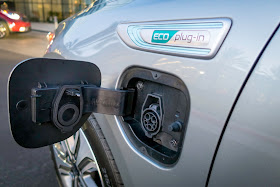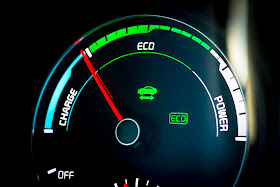 |
| The 2017 Kia Optima Plug-In Hybrid. |
Pure electrics can leave you stranded, or at the very least, unable to get where you need to go as quickly as you could with a gasoline-powered car.
Gasoline-electric hybrids use gasoline and pollute the air for at least part of most trips.
A plug-in hybrid gives you a certain amount of pure electric range before switching into hybrid mode...meaning it's at least possible, depending on your commute and other trips, to not use a single drop of gas or put a particle of tailpipe emissions into the atmosphere for days, weeks or longer.
 |
| 2017 Kia Optima Plug-In Hybrid charging port. |
The 2017 Kia Optima Plug-In Hybrid is based on a car we certainly like a lot, the Kia Optima. Its 103 MPGe EPA rating is only two less than the all-electric Kia Soul EV. That gets the Optima Plug-In Hybrid an immediate 7th-place ranking on the TireKicker's Top 10 Fuel Savers list on the right-hand side of this page. And its price is in the sweet spot for vehicles of this type: $35,210.
 |
| 2017 Kia Optima Plug-In Hybrid Eco gauge. |
Upsides? It's larger (and less controversially styled) than the 2017 Toyota Prius Prime. It's roomier than the 2017 Chevrolet Volt.
Downsides? While the Optima Plug-In offers 29 miles per charge of pure EV function, it isn't really pure EV. If it thinks conditions warrant, it will switch to hybrid mode and kick in the gasoline engine. The Prius Prime only has 25 miles range, but it is pure EV and works at speeds up to 84 miles per hour. And the Volt shames both with a pure EV range of 53 miles.
A more direct comparison, both in terms of size and range, might be the Ford Fusion Energi. The Optima beats the Fusion Energi in MPGe rating (103 to 99), because the Fusion Energi only has 22 miles of pure EV range to the Optima Plug-In Hybrid's 29.
But.
Getting that 29 miles of range on household current takes more than nine hours of charging. The Fusion gets a full charge in five.
An odd thing about the Optima Plug-In: We could never get the range indicator to read 29. Even after a lengthy charge, 27 was the highest number it would display. Usually it was 26. But actually driving it produced a different result. The office for my day job is 25 miles from home. I'd arrive with 9 miles worth of range remaining, which would last for 15 miles of the return trip. In that sense, the Kia Optima Plug-In Hybrid under-promised and over-delivered, which isn't a bad thing.
With the help of the EV range, a week's worth of driving, including a trip from Folsom to Napa and back (164 miles), wound up at 54.5 miles per gallon. Which is stellar performance for this size class.
All told, I'd have to say the 2017 Kia Optima Plug-In Hybrid is a strong choice, but not a category-killer. I wouldn't bet against the next generation.